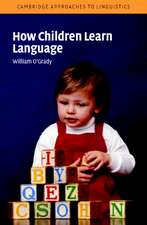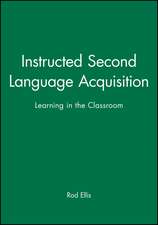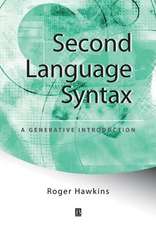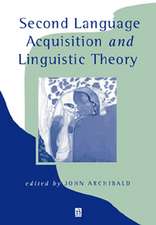The Interactional Feedback Dimension in Instructed Second Language Learning: Linking Theory, Research, and Practice: Advances in Instructed Second Language Acquisition Research
Autor Hossein Nassajien Limba Engleză Paperback – 21 sep 2016
| Toate formatele și edițiile | Preț | Express |
|---|---|---|
| Paperback (1) | 257.59 lei 6-8 săpt. | |
| Bloomsbury Publishing – 21 sep 2016 | 257.59 lei 6-8 săpt. | |
| Hardback (1) | 771.02 lei 6-8 săpt. | |
| Bloomsbury Publishing – 11 mar 2015 | 771.02 lei 6-8 săpt. |
Preț: 257.59 lei
Preț vechi: 331.22 lei
-22% Nou
Puncte Express: 386
Preț estimativ în valută:
49.30€ • 53.53$ • 41.41£
49.30€ • 53.53$ • 41.41£
Carte tipărită la comandă
Livrare economică 22 aprilie-06 mai
Preluare comenzi: 021 569.72.76
Specificații
ISBN-13: 9781350009899
ISBN-10: 135000989X
Pagini: 264
Dimensiuni: 156 x 234 x 18 mm
Greutate: 0.37 kg
Ediția:NIPPOD
Editura: Bloomsbury Publishing
Colecția Bloomsbury Academic
Seria Advances in Instructed Second Language Acquisition Research
Locul publicării:London, United Kingdom
ISBN-10: 135000989X
Pagini: 264
Dimensiuni: 156 x 234 x 18 mm
Greutate: 0.37 kg
Ediția:NIPPOD
Editura: Bloomsbury Publishing
Colecția Bloomsbury Academic
Seria Advances in Instructed Second Language Acquisition Research
Locul publicării:London, United Kingdom
Caracteristici
Examines acquisition of object pronouns from three perspectives: production, placement and processing.
Notă biografică
Hossein Nassaji, Professor of Applied Linguistics, University of Victoria, Canada
Cuprins
Series Editor ForewordPrefaceIntroduction1. Review of key conceptsPart 1. Theoretical underpinnings2. The role of corrective feedback: Theoretical and pedagogical perspectives3. Interactional feedback: Types and subtypes4. How does interactional feedback assist language acquisition?Part 2. Researching interactional feedback5. Feedback provision and learner uptake: Descriptive research6. Feedback effects on learning: Experimental and other pretest-posttest studies7. Comparative studies of interactional feedbackPart 3. Factors affecting interactional feedback8. Factors affecting the provision and usefulness of interactional feedback9. Perception and interpretation of feedbackPart 4. Linking theory, research, and practice10. Conclusions, implications, and pedagogical recommendationsReferencesIndex
Recenzii
The high quality of the present book resides in several factors that go beyond its mere content ... We here have a publication at hand that shows readers the high complexity of giving feedback in second and foreign language teaching. One of its merits is that it gives readers invaluable advice where this is possible ... An important textbook for (under)graduate courses in SLA and Applied Linguistics.
Interest in interactional feedback and its role in second language (L2) acquisition have a long history, motivated in part by teachers' concerns about whether and how to correct L2 learners and in part by theoretical issues in the field of second language acquisition. Thus a book that brings together the different pedagogical and theoretical perspectives and the research they have given rise to is most welcome. Hossein Nassaji is to be congratulated in producing an informed, comprehensive and very readable account of this body of work. His book is notable for both its breadth of coverage and the clarity with which complex issues relating to interactional feedback are discussed. This is a book that I will be referring to frequently in my own research and in my graduate-level teaching.
Nassaji has reviewed and analyzed hundreds of publications exploring the role of interactional feedback in second language learning. The book covers a range of theoretical perspectives and draws on research with young learners and adults, in classrooms and laboratory settings. Nassaji shows how the research findings can guide teachers in answering important pedagogical questions about how to respond to the errors their students make.
Hossein Nassaji's book provides an excellent and detailed review of interactionist theory and research (descriptive, experimental and comparative) related to the role of feedback in classroom-based language learning. Particularly useful is that Nassaji links theory and empirical findings to pedagogical implications, providing suggestions for enhancing the effectiveness of feedback for second language learning. Each chapter usefully begins with a set of goals for that chapter and ends with a set of discussion questions.
Interest in interactional feedback and its role in second language (L2) acquisition have a long history, motivated in part by teachers' concerns about whether and how to correct L2 learners and in part by theoretical issues in the field of second language acquisition. Thus a book that brings together the different pedagogical and theoretical perspectives and the research they have given rise to is most welcome. Hossein Nassaji is to be congratulated in producing an informed, comprehensive and very readable account of this body of work. His book is notable for both its breadth of coverage and the clarity with which complex issues relating to interactional feedback are discussed. This is a book that I will be referring to frequently in my own research and in my graduate-level teaching.
Nassaji has reviewed and analyzed hundreds of publications exploring the role of interactional feedback in second language learning. The book covers a range of theoretical perspectives and draws on research with young learners and adults, in classrooms and laboratory settings. Nassaji shows how the research findings can guide teachers in answering important pedagogical questions about how to respond to the errors their students make.
Hossein Nassaji's book provides an excellent and detailed review of interactionist theory and research (descriptive, experimental and comparative) related to the role of feedback in classroom-based language learning. Particularly useful is that Nassaji links theory and empirical findings to pedagogical implications, providing suggestions for enhancing the effectiveness of feedback for second language learning. Each chapter usefully begins with a set of goals for that chapter and ends with a set of discussion questions.























